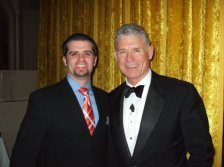
There seems to be a trend in technology: nano. Everything smaller, thinner, and powerful. We even have the Ipod nano. Growing up in Gaithersburg, MD we had the National Institute for Standards and Technology (NIST). Many people from my home church worked there and one gentlemen even had a PhD in nano technology. He would tell me about things working on sub atomic levels! I have a netbook computer that is small enough to fit into my pocket of my cargo pants. We are coming out the era of “bigger and better” that we inherited from the 1950’s where cars were as big as boats and ladies had big hair. We are entering into the age of “small things”.
In our two lectionary passages this week, we see that there is power in small things. First, we have 1 Samuel, where Samuel is grieving over King Saul’s removal from power. God instructs Samuel to invite Jesse and his sons to the sacrifice. One of his sons would become God’s anointed and would lead all of Israel. As the sons of Jesse are presented and none of them, not even the oldest, was the one that would be anointed. There was one son missing, David who was the smallest and the youngest. He was ruddy (my nickname), handsome, and full of life. You can imagine the shock that the brothers and their father felt when Samuel anointed the smallest and youngest son.
In our second passage, we find in Mark 4, Jesus is comparing the ability of a small muster seed to grow into a mighty plant to the amazing nature of planting seeds of spiritual growth within people and reaping the enormous spiritual benefits within the Kingdom of God. I always thought it was funny that Jesus talked about “shrubs”. When I think of shrubs, I always think of Monty Python and the evil knights who say “Ni!” asking for shrubbery. Continue Reading…

 Several news outlets, including the Associated Press and
Several news outlets, including the Associated Press and 

 (not that bad), and algebra II (got C’s and past, barely). I took at practical math class my senior year in high school where I learn to balance a check book, learned about mortgages, understood the stock market, and all sorts of practical mathematical concepts. I got A’s in that class! The issue I found with mathematics is that the vast majority of equations and problems you have to solve have one answer. For some reason, my mind was more suited to the humanities like government, history, art, and english (sort of). In those classes, the answer was usually subjective. In the humanity classes, thinking and discussing were at the center of learning. Memorizing math formulas and the rules of math was difficult. Every time I got a concept in math class we would move on to another concept. I could not keep up!
(not that bad), and algebra II (got C’s and past, barely). I took at practical math class my senior year in high school where I learn to balance a check book, learned about mortgages, understood the stock market, and all sorts of practical mathematical concepts. I got A’s in that class! The issue I found with mathematics is that the vast majority of equations and problems you have to solve have one answer. For some reason, my mind was more suited to the humanities like government, history, art, and english (sort of). In those classes, the answer was usually subjective. In the humanity classes, thinking and discussing were at the center of learning. Memorizing math formulas and the rules of math was difficult. Every time I got a concept in math class we would move on to another concept. I could not keep up! ven though it takes three different modes. The same can be said of the Trinity. God is still God, but just in three forms that share similar properties made up of one substance. It’s crazy, I know. Similes and metaphors get us close to an idea, but never fully explain it. Trying to explain God is like trying to explain an emotion. Words that can fully describe it. How do you describe the Divine? How do you describe something greater than ourselves? We have some pretty good ways of describing God, but nothing can fully explain God. There is a certain mystery there that we are meant to be in awe of.
ven though it takes three different modes. The same can be said of the Trinity. God is still God, but just in three forms that share similar properties made up of one substance. It’s crazy, I know. Similes and metaphors get us close to an idea, but never fully explain it. Trying to explain God is like trying to explain an emotion. Words that can fully describe it. How do you describe the Divine? How do you describe something greater than ourselves? We have some pretty good ways of describing God, but nothing can fully explain God. There is a certain mystery there that we are meant to be in awe of. 
 For the last 20 or 25 years, it has become popular a church to build their worship and ministry space to look like a warehouse or storehouse (or use an actual warehouse). After being a part of three capital improvement projects at three different churches, I have found there is a whole theology to church buildings.
For the last 20 or 25 years, it has become popular a church to build their worship and ministry space to look like a warehouse or storehouse (or use an actual warehouse). After being a part of three capital improvement projects at three different churches, I have found there is a whole theology to church buildings. vention.
vention.
